| Turbomachinery |   |
Inside a turbomachine can be changed of enthalpy, kinetic energy and potential energy of a working gas according the equation for First law of thermodynamics for open system and it is can use for all types of turbomachines. In next chapters there is description of transformation energy for various types of the turbomachines (include losses), so as it is usually used under practice.
In chapter Internal power output/input of turbomachine Pi is defined specific internal work ai. Other internal parameter of machine is its internal efficiency(1) ηi, which defines an quality of transformation of energy inside machine through a comparation real specific internal work with ideal specific internal work of the machine. Difference between the real specific internal work and ideal specific internal work is called specific internal losses of system/machine z(2).
The water turbines can transform potential, kinetic and pressure energy of a working liquid to work and heat-internal losses (increase of internal energy of water):
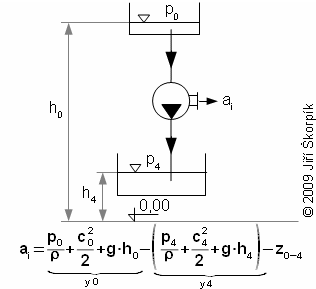 |
1.303 Specific internal work of a water turbine. ai [J·kg-1] specific internal work; p [Pa] pressure of working liquid; c [m·s-1] absolute velocity of flow; ρ [kg·m-3] density of working liquid; g [m·s-2] gravitational acceleration; h [m] height of levels; y [J·kg-1] specific total energy of working liquid; z [J·kg-1] specific internal losses. Derived from Bernoulli equation. |
An internal efficiency of the water turbine is ratio between ai and the change of specific total energy of the working liquid between the inlet flange and the exit flange:
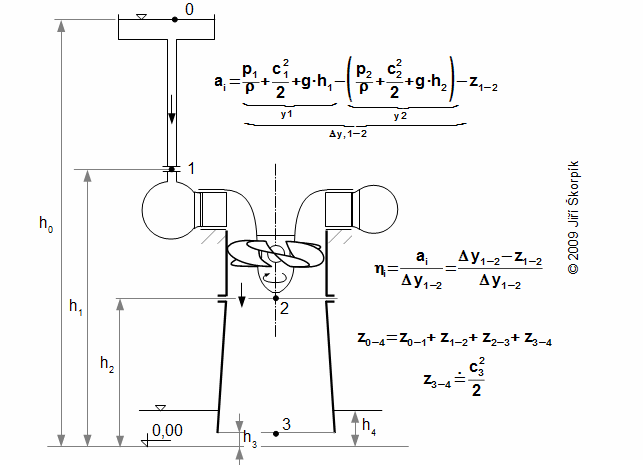
The water turbine are one of the most efficiency turbomachines with ηi up to 95 %.
The water turbine usually feeds an electric generator, which has adequate power on its contacts.

For technical reasons and safety of the water turbines are not placed tightly above the level of lower tank (a risk of flooding of machine room etc.). Hence, for case turbine with the reaction stage is inserted a draft tube between the turbine and the lower tank:
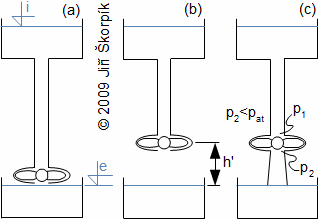
The end of the draft tube is tightly below the surface of the lower tank and is filled water. Its height is function of difference of pressure between the turbine exit and the surface in lower tank. It evident, the pressure on the turbine exit must be less then the pressure on the surface of the lower tank. The pressure on the turbine exit p2 must not be less then saturation pressure of water in this point. In the opposite case the water column would be crashed under development of steam. Because pressure p2 is less than pressure p4 is the specific internal work of the turbine similar as for case a turbine without the draft tube, which is just above the surface of the lower tank. Through use of the draft tube can be used whole difference h.
This case is similar such as the water turbines, but in rotodynamic pumps is transformed work (internal power input of the rotodynamic pump) to energy of the working liquid (potential, kinetic, pressure energy). The purpose of the pumps is to increase of specific total energy of the working liquid from a state y0 to required state y3:
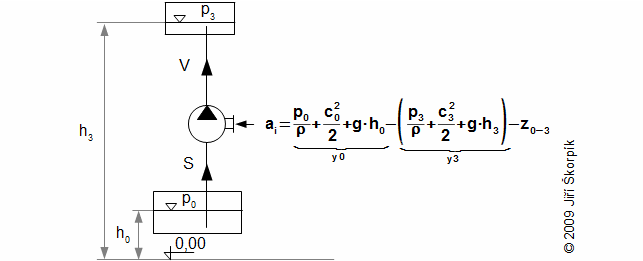
Internal efficiency of the pump is ratio between the change of the total energy of the liquid during flow through the pump and the absolute value of internal work ai:

Maximum ηi of pumps can be higher then 90 %.
During pumping of the working liquid can be neglected change of kinetic energy between the surface inside the suction and the delivery tank:
 |
7.302 A practical calculation of an increasing of the specific total energy of the working liquid inside the pump. The losses are calculated from a characteristic of piping system. The end of the tube is on a flanges of the pump. The derivation of this equation is shown in the Appendix 302. |
Inside a heat turbine is transformed heat and ethalpy to work during expansion of the working gas. The working substance (liquid, gas, steam ...) is usually heated outside turbine, e.g. in case of steam turbines is made steam inside steam boiler (steam cycle), in case of a combustion turbine is made hot gas inside a combustion chamber in front of turbine (Brayton cycle).

The expansion of the working gas can be adiabaticaly(3) inside heat turbine, therefore q=0 nebo q≈0. There are cases where heat transfer with surroundings has influence on expansion (so called polytropic expansion q≠0). In two next chapters is descripted the cases adiabatic and polytropic expansion inside heat turbines.
The working gas inside turbine expands from pressure pi on pressure pe. If the turbine is isolated system then entropy of working gas must be constant or increasing. This increase of entropy is caused by loss heat (local temperature differences, which arise during turbulence and a friction of the working gas on machine parts, flow of the working gas through leakages inside the stage and mixing etc.). For illustrate the heat flows inside the heat machine are used i-s diagram and T-s diagram:
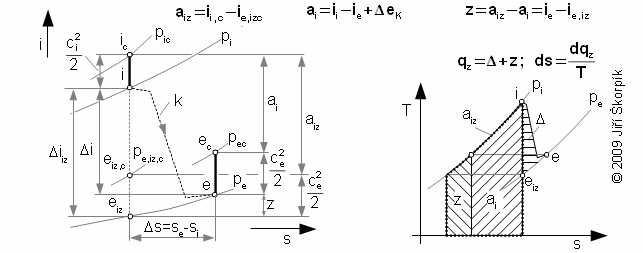
For the difference specific enthalpy ii-ie can be use the equation also:

From previous equations is evident, maximum ai at adiabatic expansion is reached for case isentropic process, therefore the isentropic expansion is used as comparative for assessment of internal efficiency of the heat turbine:
 |
11.604 The internal efficiency of the heat turbine in relation to isentropic process. |
Maximum ηi of heat turbines can be higher than 90 % (for case steam turbines 92% – for case multi-casing steam turbines, but the internal efficiency of individual turbine casings can be difference.
In cases heat transfer with surroundings influences expansion inside turbine. For example a cooling of temperature stressed of parts of the turbine etc. For these cases the expansion is more similar a polytropic expansion than adiabatic expansion.
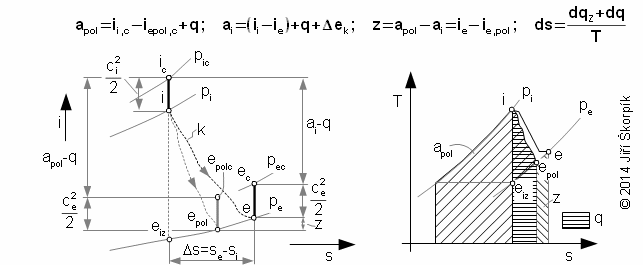
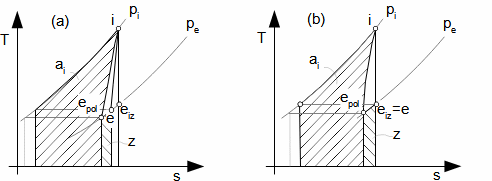
For case polytropic equations is maximum ai reached for case reversible polytropic expansion, therefore the reversible polytropic expansion is used as comparative for assessment of internal efficiency of heat turbine at polytropic expansion:
 |
14.908 Internal efficiency of turbine in relation to reversible polytropic expansion. ap [J·kg-1] specific work at comparative (proposed) ideal polytropic expansion (usually isothermal expansion). |
The above knowledge can be also applied to the description of expansion at heat transfer with surroundings in one stage of heat turbine.
Inside the compressor is transformed work to the pressure energy of working gas.

The compression of the working gas can be presumed adiabaticaly inside compressor, therefore q=0 nebo q≈0. There are cases where heat transfer with surroundings has influence on the compression (so called polytropic compression q≠0). In two next chapters is descripted the cases adiabatic and polytropic compression inside heat compressors.
The working gas is compressed from pressure pi on pressure pe inside the compressor. Also inside the turbocompressor arises the specific losses heat qz, which increase of the entropy as for case the turbine (see a description above the Equation 9):

If is not known i-s diagram of the working gas, is can used for a calculation of enthalpy difference ii-ie also the Equation 10.
At adiabatic compression can be maximum ai reached for case isentropic compression, therefore the isentropic compression is used as comparative for assessment of the internal efficiency of the compressor at adiabatic compression:
 |
17.609 Internal efficiency of the compressor at adiabatic compression. |
A median of ηi is about 80 %, but for the best of constructions achieved 89 to 91 %.
A significant parameter of the compressors is also the compression ratio of compressor of the static or stagnation pressures:
 |
18.610 The compression ratio of the compressor. ε [-] compression ratio. |
The turbocompressor is driven by an electrical engine, by combustion turbine or turbo-expander. The turbocompressor is driven by a steam turbine in industrial plants with high consumption of pressurized air.
In cases heat transfer with surroundings influences compression inside compressors. For example a turbocompressor with cooling etc. For these cases the compression is more similar a polytropic compression than adiabatic compression.
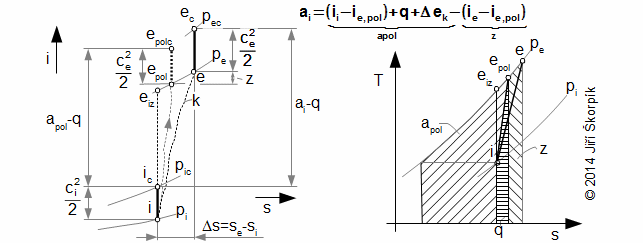

At polytropic compression can be maximum ai reached for case reversible polytropic compression, therefore the reversible polytropic compression is used as comparative for assessment of the internal efficiency of the compressor at polytropic compression:
 |
21.1003 Internal efficiency of compressor in relation to reversible polytropic compression. ap [J·kg-1] specific work at comparative (proposed) ideal polytropic compression (ap≠apol, because apol is influenced by losses at real compression see problem [26.612]). |
The above knowledge can be also applied to the description of compression at heat transfer with surroundings in one stage of turbomachine.
The fans are machines, which provide force of gas flow (compensate of pressure losses) with a small increase of its pressure. For calculation of the fans are usually used assumptions ρ≈const., t≈const.-incompressible flow. The work for the working gas is transformed on the pressure energy and the kinetic energy, a change of potential energy is negligible inside the fan. Because the compression ratio εc in the fan is very small is better to describe the transformation energy based on the increase stagnation pressure Δpc, then from equation of First law of thermodynamic for open system:
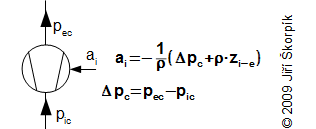 |
22.309 Specific internal work of the fan shown in i-s digram. Δpc [Pa] increase of stagnation pressure in fan. The assumption: potential energy is negligible. The derivation of this equation is shown in the Appendix 309. |
The internal efficiency of the fan is defined as ratio between specific internal work of the fan without losses and the internal work of the fan:
 |
23.581 Internal efficiency and power input of the fan. V• [m3·s-1] volume flow; m˙ [kg·s-1] mass flow rate through fan. |
A portion of the kinetic energy, which flows through the rotor of the wind turbine is transformed to work (in case is negligible influence potential energy, internal heat energy and pressure energy). The flow area of the stream-tube of the wind rotor is increases under decreasing of the wind velocity inside. The slow-motion air flow of air behind the turbine is a barrier for surrounding flow (the flow on outside stream-tube), which must gradually wrap it. Therefore the stream-tube is developed (separated air flow, which flows through rotor from other air flow) far upstream of the turbine. Specific work of wind turbine is specific work of air inside stream-tube of rotor:
The axial wind turbine is a reaction stage. The stream-tube in front of turbine works as of a diffuser (pressure increasing) where the kinetic energy is transformed to pressure energy. The stream-tube behind turbine works as of a draft tube, because closely behind of turbine is developed a underpressure:

Efficiency of wind turbine ηi is defined as the ratio between specific work ai and the specific optimum work of the wind turbine, which is reached if absolute velocity ce is one third of the absolute velocity ci:

The propellers, marine propellers are machines without a housing. The transformation energy by these machines is similar as for the case the wind turbines. The kinetic energy of the working fluid during flow through the rotor is increased-the velocity is increasing:
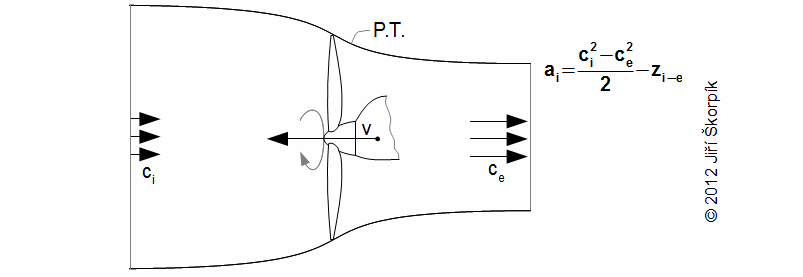
The propeller is used to make a thrust – a force, which causes a motion of an airplane or it is used for overcome the drag forces and weight forces during uniform flight. The most significant function of the propeller is to make the thrust:

The most significant quantity of the propeller drive is the thrust T, which allows the airplane an flight with velocity v, therefore the efficiency of the propeller is function these both quantities. The efficiency of the propeller shows qualitation of transformation of power input to the thrust. The efficiency transformation kinetic energy of realtive velocities of flow to the thrust is called propulsion efficiency:
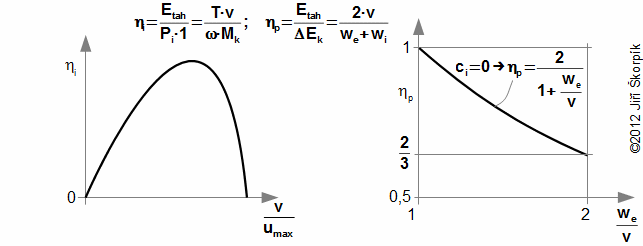
For optimal condition of the flight is efficiency of propeller ηi more than 90 % and efficiency ηprop circa 85 % [2, p. 613].
This document is English version of the original in Czech language: ŠKORPÍK, Jiří. Energetické bilance lopatkových strojů, Transformační technologie, 2009-10, [last updated 2017-11-19]. Brno: Jiří Škorpík, [on-line] pokračující zdroj, ISSN 1804-8293. Dostupné z https://www.transformacni-technologie.cz/13.html. English version: Energy balances of turbomachines. Web: http://www.transformacni-technologie.cz\en_13.html.